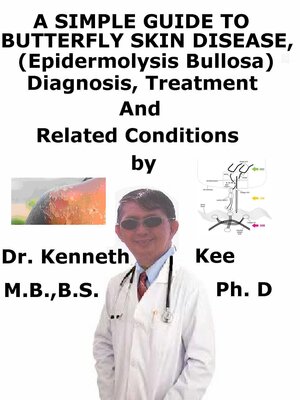A Simple Guide to Butterfly Skin Disease (Epidermolysis Bullosa), Diagnosis, Treatment and Related Conditions
ebook
By Kenneth Kee

Sign up to save your library
With an OverDrive account, you can save your favorite libraries for at-a-glance information about availability. Find out more about OverDrive accounts.
Find this title in Libby, the library reading app by OverDrive.



Search for a digital library with this title
Title found at these libraries:
| Library Name | Distance |
|---|---|
| Loading... |
This is one of the interesting disorders that I came across while reading about skin disorders.
This book describes Butterfly Skin Disease (Epidermolysis Bullosa), Diagnosis and Treatment and Related Diseases.
Epidermolysis bullosa is a rare chronic non-inflammatory skin disorder that is normally inherited.
It induces the skin to be incredibly thin and brittle.
People who are born with this disorder are often known as "butterfly children" since their diseased skin is as delicate as a butterfly's wings.
Blistering of the skin often materializes in infancy in reaction to simply being held or handled.
Epidermolysis bullosa (EB) is a group of inherited diseases that are in which large blisters and erosion develop after the slightest trauma to the skin and mucous membranes.
These may arise anywhere on the body but most often appear at areas of friction and minor trauma such as the feet and hands.
In some types, blisters may also develop in internal organs, such as the esophagus, stomach and respiratory tract, without any obvious friction.
In severe forms of the disorder, epidermolysis bullosa can be life-threatening.
Most forms of epidermolysis bullosa are produced by a genetic mutation inherited from one or both parents that affects the production of the proteins in the skin.
Epidermolysis bullosa simplex 70%
Dystrophic epidermolysis bullosa 25%
Junctional Epidermolysis bullosa 5%
Kindler syndrome rare
There is another category of epidermolysis bullosa that is not produced by a genetic mutation.
Epidermolysis bullosa acquisita develops instead as an autoimmune disorder.
Fragile or butterfly skin that blisters and tears is frequent in all forms of epidermolysis bullosa
Pain and itching often appear with the blisters and tears.
Thick skin on the palms of the hands or soles of the feet
Rough or thick fingernails or toenails
Changes in skin color or tone
Scarring and tightening of the skin
Blisters inside the mouth and throat
Dental problems such as tooth decay
Difficulty swallowing (dysphagia)
Blisters around the eyes and nose
Normally epidermolysis bullosa blisters are seen at birth and during infancy.
Epidermolysis bullosa blisters may not appear until a toddler first starts to walk or when an older child starts new physical activities that trigger more friction on the soles of the feet
A visual inspection of the skin and presenting signs may also be sufficient to make a diagnosis.
In most cases a skin biopsy of a newly induced blister might be done to confirm the diagnosis.
Families with a history of epidermolysis bullosa may need prenatal genetic testing and genetic counseling
There is no cure for epidermolysis bullosa, no matter the type.
The treatment of butterfly skin disease is mainly preventive and supportive.
Wound care
Medicines to relieve pain and inflammation
Preventing new injuries
Avoiding complications
Rehabilitation therapy
Providing good nutrition
Surgeries that are occasionally used for this disorder are:
Widening the esophagus
Placing a feeding tube
Grafting skin
Restoring movement using surgical intervention to treat contractures
Surgical excision of squamous cell carcinoma
Possible future treatments
Doctors are studying new ways to treat epidermolysis bullosa:
Gene therapy, such as gel applied to wounds of people with dystrophic epidermolysis bullosa
Bone marrow (stem cell) transplantation
Protein replacement therapy
TABLE OF CONTENT
Introduction
Chapter 1 Butterfly Skin...







